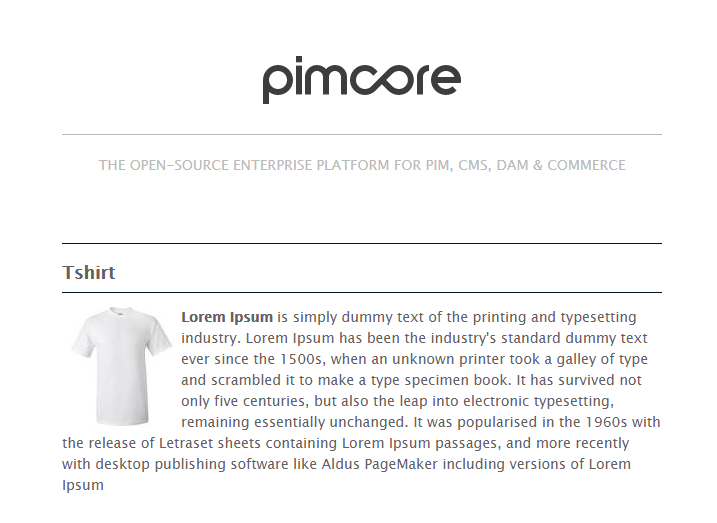In this part, you are going to see a required minimum of knowledge, crucial for start developing with Pimcore.
Creating CMS Pages with Documents
In the first part you'll learn the basics for creating CMS pages with Pimcore Documents.
Create Template, Layout and Controller
New Controller
First of all, we need a controller.
Let's call it ContentController.php.
You have to put the file into the /src/AppBundle/Controller directory.
<?php
namespace AppBundle\Controller;
use Pimcore\Controller\FrontendController;
use Symfony\Component\HttpFoundation\Request;
class ContentController extends FrontendController
{
public function defaultAction(Request $request)
{
}
}
For the moment we only have one single action called defaultAction().
In the defaultAction, we can put some custom code or assign values to the template. For this example we
don't need any custom code in our controller, so the action stays empty for the moment.
Create a Template
Now we create a template for our page:
- Create a new folder in
/app/Resources/viewsand name it like the controller (in this caseContent). - Put a new PHP template into this folder and name it like our action in lowercase (
default.html.php).
Then we can put some template code into it, for example:
<?php
/**
* @var \Pimcore\Templating\PhpEngine $this
* @var \Pimcore\Templating\PhpEngine $view
* @var \Pimcore\Templating\GlobalVariables $app
*/
$this->extend('layout.html.php');
?>
<h1><?= $this->input("headline", ["width" => 540]); ?></h1>
<?php while ($this->block("contentblock")->loop()) { ?>
<h2><?= $this->input("subline"); ?></h2>
<?= $this->wysiwyg("content"); ?>
<?php } ?>
Pimcore uses by default an improved version of the Symfony PHP templating engine (PhpEngine) and therefore plain PHP as template language. So you have the full power of
Symfony templates with all Symfony functionalities available. In addition to that, there are some Pimcore specific additions like the so called editables,
which add editable parts (placeholders) to the layout and some custom templating helpers.
We've improved the default Symfony PHP engine, by adding the $this context, which is basically the same as using
the $view variable or local variables when using the default Symfony syntax. However the default syntax is still available and ready to use.
For details concerning editables (like $this->input, $this->block, ...) see Editables.
Add a Layout
We can use Symfony`s template inheritance and layout functionality to wrap our content page with another template which contains the main navigation, a sidebar, … using the following code:
$this->extend('layout.html.php');
We tell the engine that we want to use the layout layout.html.php.
Now create a new PHP template in the folder /app/Resources/views and name it layout.html.php.
Then we can also put some HTML and template code into it:
<?php
/**
* @var \Pimcore\Templating\PhpEngine $this
* @var \Pimcore\Templating\PhpEngine $view
* @var \Pimcore\Templating\GlobalVariables $app
*/
?>
<!DOCTYPE html>
<html lang="en">
<head>
<meta charset="UTF-8">
<title>Example</title>
<link rel="stylesheet" type="text/css" href="/static/css/global.css" />
</head>
<body>
<div id="site">
<div id="logo">
<a href="http://www.pimcore.org/"><img src="/bundles/pimcoreadmin/img/logo-gray.svg" style="width: 200px;" /></a>
<hr />
<div class="claim">
THE OPEN-SOURCE ENTERPRISE PLATFORM FOR PIM, CMS, DAM & COMMERCE
</div>
</div>
<div class="info">
<?php $this->slots()->output('_content') ?>
</div>
</div>
</body>
</html>
The code <?php $this->slots()->output('_content') ?> is the placeholder where the content of the page will be inserted.
Putting it all together with Pimcore Documents
Now we need to connect the action to a page in the Pimcore backend, so that the page knows which action (and therefore also which template) needs to be executed/processed. First, click right on Home in the Documents panel.
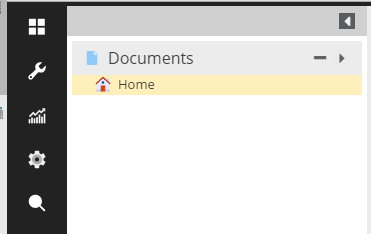
Now select the tab Settings in the newly opened tab. Select the name of the controller and the name of the action in the according fields.

You can test the new controller and action, after saving the document (press Save & Publish). Select the tab Edit, to see your page with all the editable placeholders.
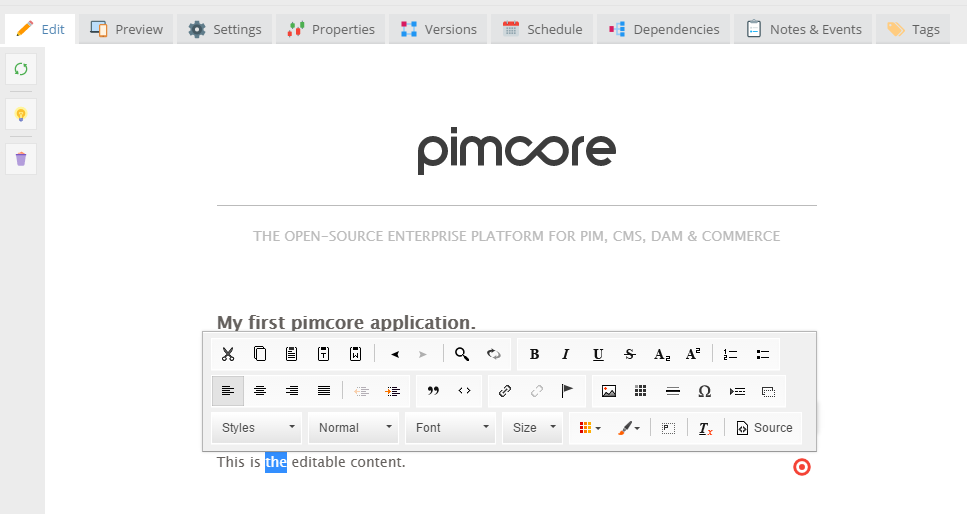
Introduction to Assets
In assets, all binary files like images, videos, office files and PDFs, ... can be uploaded, stored and managed. You can organize them in a directory structure and assign them additional meta data. Once uploaded, an asset can be used and linked in multiple places - e.g. documents or objects.
In terms of images or videos, always upload only one high quality version (best quality available). Thumbnails for different output channels are created directly within Pimcore using custom configurations.
For this tutorial, at least add one file which you will use in an object later.
There are many ways to upload files:
- Drag & drop files from your file explorer into the browser on the desired asset folder
- Right click on Home and choose the most suitable method for you
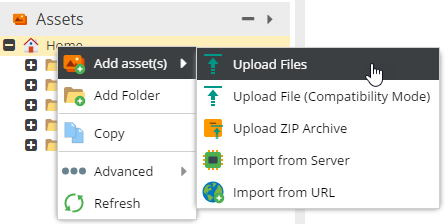
Introduction to Objects
We've already made a controller, action and a view so we're able to add text from within the admin panel to our pages. In this chapter we will create a simple product database and use them in our CMS pages. Objects are used to store any structured data independently from the output-channel and can be used anywhere in your project.
Create the Class Model/Definition
Go to: Settings -> Object -> Classes and click the button Add Class.
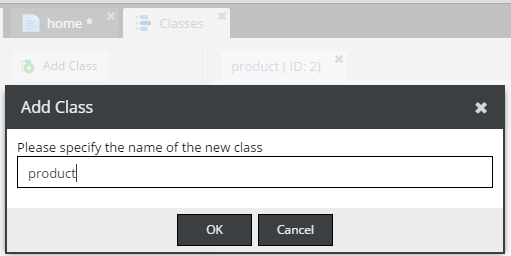
Now, there is a new product class/model which is a representation of your entity including the underlying database scheme as well as a generated PHP class you can use to create, update, list and delete your entities.
More specific backgrounds and insights can be found in the Objects section
The product should have the following attributes: SKU, picture, name and description. Follow these steps to add them:
- Go to the edit page of the class product
- Click right on Base and select Add Layout Component -> Panel - This is the main panel/container for the following product attributes
- To add attributes:
- Click right on Panel, then Add data component -> Text -> Input, then change the name of the input component to sku (in the edit panel on the right side)
- Just the same way you add the new data field for name
- Now we're going to add a WYSIWYG attribute for the description. Again, click right, select Add data component -> Text -> WYSIWYG. We name it description.
- The last attribute is for the picture. We can use on of the specialized image components in Other -> Image. Name the attribute picture.
If everything goes well, the new class looks like in the picture:
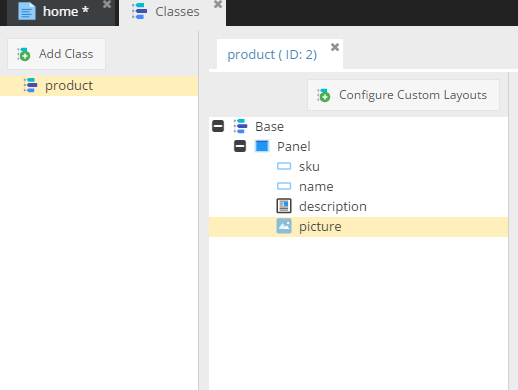
Important: Every generated class in the Pimcore admin panel has also an accordingly PHP class
with getters and setters. You can find the PHP class representation of our newly created class definition above in
var/classes/DataObject/Product.php
Add a new Object
We've just prepared a simple class for new products. Now we can use it to create objects in Pimcore.
- Open the objects section on the left and click on the right button after Home (Note that you can create also directories structure for objects).
- Choose Add object -> product and fill the input with a name, for example: tshirt
- Add values for sku, name and description attributes.
- Click Save & Publish
Probably, your view looks like below:
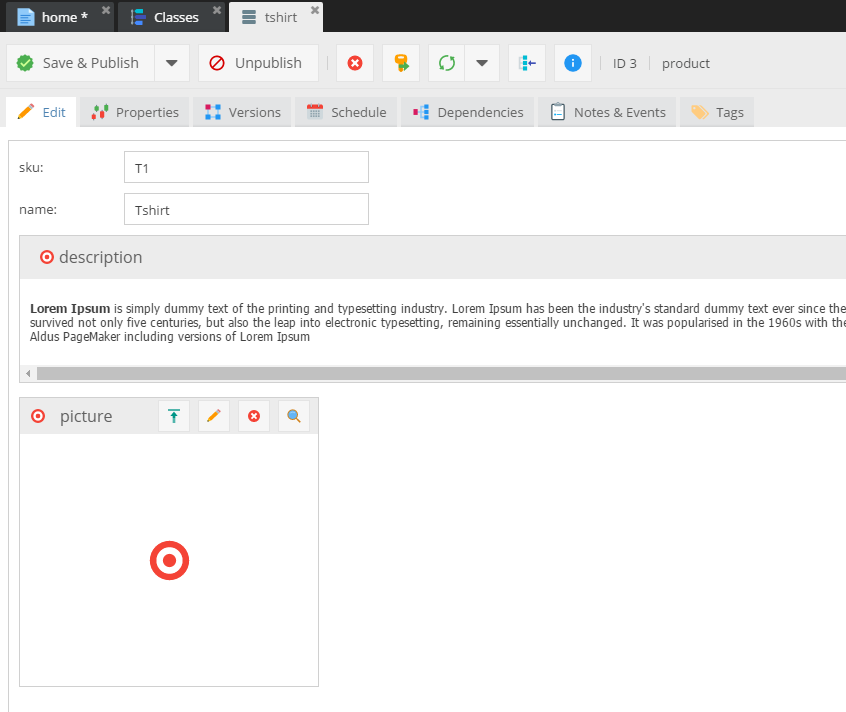
The last step to finish the product object is add a photo.
The one way to upload a photo is this button:  or just drag file which you uploaded from Assets section.
or just drag file which you uploaded from Assets section.
Click Save & Publish button.
That's it.
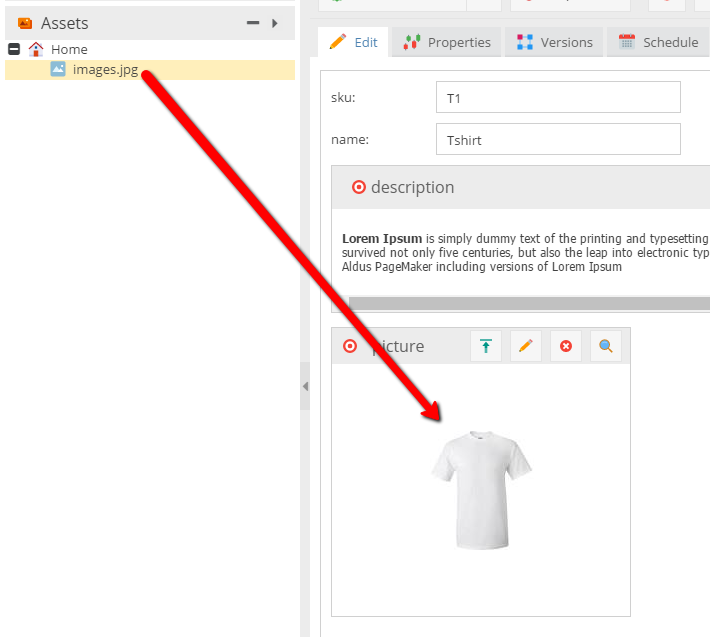
Putting the Pieces Together
Let's put the pieces together and connect the products to the CMS.
Update Controller and Template
Therefore create another action in the controller (ContentController) called productAction.
<?php
namespace AppBundle\Controller;
use Pimcore\Controller\FrontendController;
use Symfony\Component\HttpFoundation\Request;
class ContentController extends FrontendController
{
public function defaultAction (Request $request)
{
}
public function productAction(Request $request)
{
}
}
Then we also need a new template for our product action: app/Resources/views/Content/product.html.php
<?php
/**
* @var \Pimcore\Templating\PhpEngine $this
* @var \Pimcore\Templating\PhpEngine $view
* @var \Pimcore\Templating\GlobalVariables $app
*/
$this->extend('layout.html.php');
?>
<h1><?= $this->input("headline", ["width" => 540]); ?></h1>
<div class="product-info">
<?php if($this->editmode):
echo $this->relation('product');
else: ?>
<!-- Product information-->
<?php endif; ?>
</div>
$this->editmode is a standard variable (is always set) to check if the view is called from the Pimcore admin backend and gives you the
possibility to do different stuff in editmode and in frontend.
$this->relation('product') is one of the possible editable placeholders. It can be used to make 1 to 1 relations, a cool
alternative for that, would be also the Renderlet editable.
Click here for a full list of available editables in Pimcore.
Add the Product Object to a Document
The last thing is to show the product in the body of the document you created.
Let's go back to the documents section. Right click on Home then Add Page > Empty Page.
In the settings label, choose the product action and the Content controller, click save and go back to the edit tab.
Now you can see the new editable element (relation) which we added in the product template above.
Drag the product object to that editable and press Save & Publish.

Let's see what happened on the frontend...
Go to the product page. In my case, let's say http://pimcore.local/tshirt where tshirt is the identifier of the product (the name visible the documents tree).
We haven't implemented frontend features yet, therefore the page doesn't contain any product information.
In the template file (app/Resources/views/Content/product.html.php) add few lines:
<?php
/**
* @var \Pimcore\Templating\PhpEngine $this
* @var \Pimcore\Templating\PhpEngine $view
* @var \Pimcore\Templating\GlobalVariables $app
*/
$this->extend('layout.html.php');
?>
<h1><?= $this->input("headline", ["width" => 540]); ?></h1>
<div class="product-info">
<?php if($this->editmode):
echo $this->relation('product');
else: ?>
<div id="product">
<?php
/** @var \Pimcore\Model\DataObject\Product $product */
$product = $this->relation('product')->getElement();
?>
<h2><?= $this->escape($product->getName()); ?></h2>
<div class="content">
<?= $product->getDescription(); ?>
</div>
</div>
<?php endif; ?>
</div>
You are now able to access the linked object above by using the method getElement().
Now you have access to the entire data from the linked object (name, description, ...).
It's a good practice to add @var PHPDoc in every view, to benefit from auto-complete in your IDE.
Add a Thumbnail Configuration
To show the product image in the view, we need to add a thumbnail configuration first. Using thumbnail configurations, Pimcore automatically renders optimized images for certain output channels (including high-res @2x versions).
For adding a thumbnail configuration see the following screen. Just add a configuration named content.
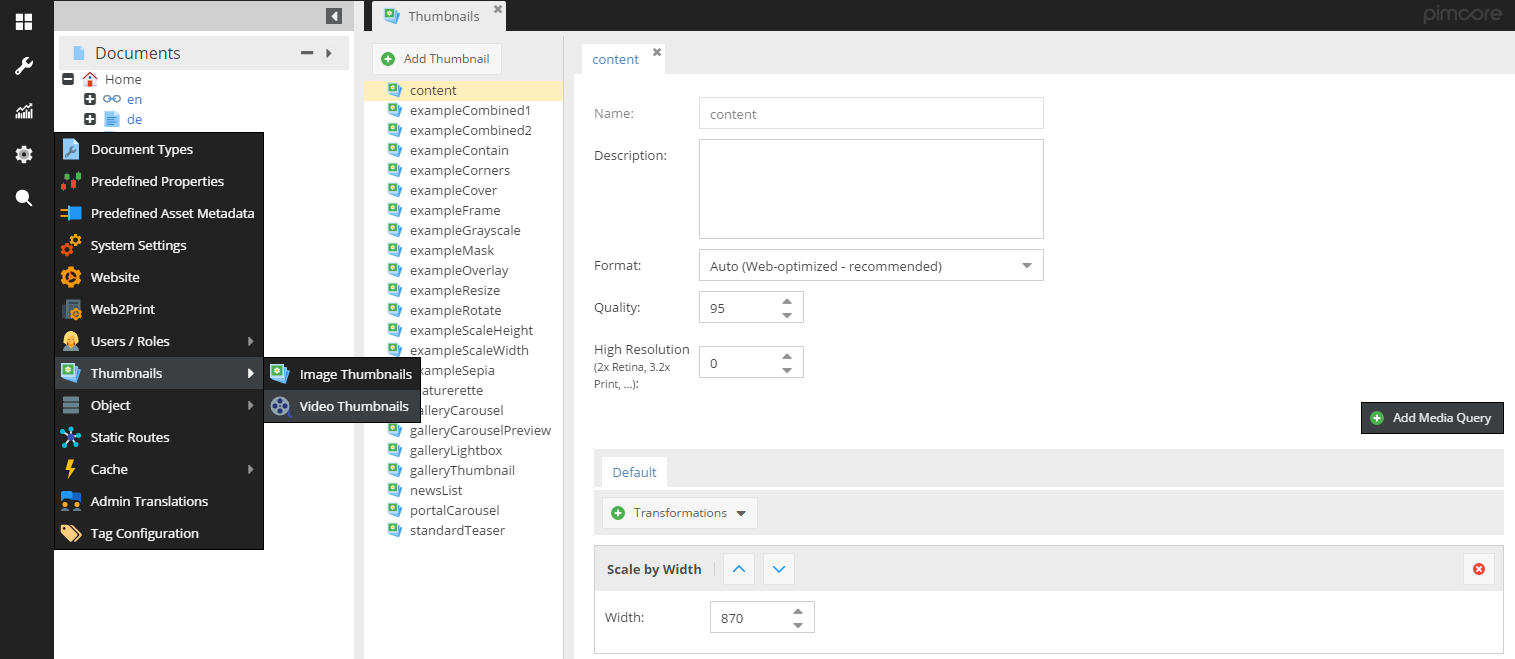
Showing the Image in the View
Now, last but not least, we would like to show the product picture:
<div class="content">
<?php
$picture = $product->getPicture();
if($picture instanceof \Pimcore\Model\Asset\Image):
/** @var \Pimcore\Model\Asset\Image $picture */
?>
<?= $picture->getThumbnail("content")->getHtml(); ?>
<?php endif; ?>
<?= $product->getDescription(); ?>
</div>
As you can see, image attribute is an additional class with useful parameter.
To print out the image in the right size just use the method getThumbnail()->getHtml() which returns the <img> or <picture> (when using media queries in your config) tag with the
correct image path and also sets alt attributes to values based on the asset meta data.
Now the product page should look like:
